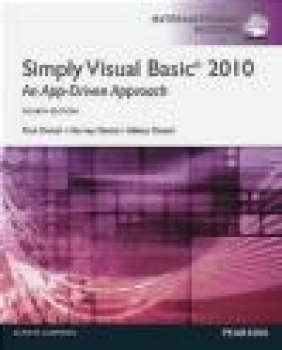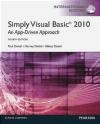Simply Visual Basic 2010: an App-driven Approach
Harvey Deitel, Abbey Deitel, Paul Deitel
Simply Visual Basic 2010: an App-driven Approach
Harvey Deitel, Abbey Deitel, Paul Deitel
- Producent: Pearson
- Rok produkcji: 2012
- ISBN: 9780273776819
- Ilość stron: 848
Niedostępna
Opis: Simply Visual Basic 2010: an App-driven Approach - Harvey Deitel, Abbey Deitel, Paul Deitel
For introductory courses in Visual Basic Programming, offered in departments of Information Technology, Computer Science or Business. Merging the concept of a lab manual with that of a conventional textbook, the Deitels have crafted an innovative approach that enables students to learn programming while having a mentor-like book by their side. This best-seller blends the Deitel signature Live-Code Approach with their Application-Driven methodology. Students learn programming and Visual Basic by working through a set of applications. Each tutorial builds upon previously learned concepts while learning new ones. An abundance of self assessment exercises are available at the end of most chapters to reinforce key ideas. This approach makes it possible to cover a wealth of programming constructs within the Visual Basic 2010 environment. View the Deitel Buzz online to learn more about the newest publications from the Deitels.Preface viii 1 Test-Driving a Painter App 1 Introducing Computers, the Internet and Visual Basic 1 1.1 Computing in Business, Industry and Research 1 1.2 Hardware and Software 5 1.3 Data Hierarchy 6 1.4 Computer Organization 8 1.5 Machine Languages, Assembly Languages and High-Level Languages 10 1.6 Object Technology 11 1.7 Microsoft's Windows(R) Operating System 13 1.8 Programming Languages 13 1.9 Visual Basic 14 1.10 The Internet and the World Wide Web 15 1.11 Microsoft .NET 16 1.12 Web 2.0: Going Social 17 1.13 Test-Driving the Visual Basic Advanced Painter App 21 1.14 Web Resources 24 1.15 Wrap-Up 24 2 Welcome App 37 Introducing the Visual Basic 2010 Express IDE 37 2.1 Test-Driving the Welcome App 37 2.2 Overview of the Visual Studio 2010 IDE 38 2.3 Creating a Project for the Welcome App 40 2.4 Menu Bar and Toolbar 45 2.5 Navigating the Visual Studio IDE 47 Solution Explorer 48 Toolbox 49 Properties Window 49 2.6 Using Help 51 2.7 Saving and Closing Projects in Visual Basic 53 2.8 Web Resources 53 2.9 Wrap-Up 54 3 Welcome App 65 Introduction to Visual App Development 65 3.1 Test-Driving the Welcome App 65 3.2 Constructing the Welcome App 68 3.3 Objects Used in the App 78 3.4 Wrap-Up 78 4 Designing the Inventory App 106 Introducing TextBoxes and Buttons 106 4.1 Test-Driving the Inventory App 106 4.2 Constructing the Inventory App 108 4.3 Adding Labels to the Inventory App 112 4.4 Adding TextBoxes and a Button to the Form 115 4.5 Wrap-Up 118 5 Completing the Inventory App 135 Introducing Programming 135 5.1 Test-Driving the Inventory App 135 5.2 Introduction to Visual Basic Program Code 136 5.3 Inserting an Event Handler 139 5.4 Performing a Calculation and Displaying the Result 143 5.5 Using the IDE to Eliminate Compilation Errors 146 5.6 Wrap-Up 149 6 Enhancing the Inventory App 163 Introducing Variables, Memory Concepts and Arithmetic 163 6.1 Test-Driving the Enhanced Inventory App 163 6.2 Variables 164 6.3 Handling the TextChanged Event 167 6.4 Memory Concepts 169 6.5 Arithmetic 170 6.6 Using the Debugger: Breakpoints 172 6.7 Wrap-Up 175 7 Wage Calculator App 190 Introducing Algorithms, Pseudocode and Program Control 190 7.1 Test-Driving the Wage Calculator App 190 7.2 Algorithms 191 7.3 Pseudocode 192 7.4 Control Statements 193 7.5 If...Then Selection Statement 195 7.6 If...Then...Else Selection Statement and Conditional If Expressions 197 7.7 Constructing the Wage Calculator App 200 7.8 Assignment Operators 204 7.9 Formatting Text 205 7.10 Using the Debugger: The Watch Window 207 7.11 Wrap-Up 210 8 Dental Payment App 225 Introducing CheckBoxes and Message Dialogs 225 8.1 Test-Driving the Dental Payment App 225 8.2 Designing the Dental Payment App 228 8.3 Using CheckBoxes 229 8.4 Using a Dialog to Display a Message 231 8.5 Logical Operators 235 Using AndAlso 235 Using OrElse 236 Short-Circuit Evaluation 237 Using Xor 237 Using Not 237 8.6 Designer-Generated Code 240 8.7 Wrap-Up 241 9 Car Payment Calculator App 256 Introducing the Do While...Loop and Do Until...Loop Repetition Statements 256 9.1 Test-Driving the Car Payment Calculator App 256 9.2 Do While...Loop Repetition Statement 258 9.3 Do Until...Loop Repetition Statement 260 9.4 Constructing the Car Payment Calculator App 262 9.5 Wrap-Up 269 10 Class Average App 282 Introducing the Do...Loop While and Do...Loop Until Repetition Statements 282 10.1 Test-Driving the Class Average App 282 10.2 Do...Loop While Repetition Statement 284 10.3 Do...Loop Until Repetition Statement 286 10.4 Creating the Class Average App 288 10.5 Wrap-Up 294 11 Interest Calculator Application 308 Introducing the For...Next Repetition Statement and NumericUpDown Control 308 11.1 Test-Driving the Interest Calculator Application 308 11.2 Essentials of Counter-Controlled Repetition 310 11.3 Introducing the For...Next Repetition Statement 311 11.4 Examples Using the For...Next Statement 315 11.5 Constructing the Interest Calculator Application 315 11.6 Wrap-Up 323 12 Security Panel Application 332 Introducing the Select Case Multiple-Selection Statement 332 12.1 Test-Driving the Security Panel Application 332 12.2 Introducing the Select Case Multiple-Selection Statement 334 12.3 Constructing the Security Panel Application 336 12.4 Wrap-Up 344 13 Enhancing the Wage Calculator Application 352 Introducing Function Procedures and Sub Procedures 352 13.1 Test-Driving the Enhanced Wage Calculator Application 352 13.2 Classes and Procedures 353 13.3 Function Procedures 354 13.4 Using Sub Procedures in the Wage Calculator Application 363 13.5 Using the Debugger: Debugging Controls 368 13.6 Optional Parameters 372 13.7 Wrap-Up 373 14 Shipping Time Application 381 Using Dates and Timers 381 14.1 Test-Driving the Shipping Time Application 381 14.2 Date Variables 382 Declaring a Date Variable 382 Using Date Members 383 14.3 Creating the Shipping Time Application: Design Elements 385 14.4 Creating the Shipping Time Application: Inserting Code 391 14.5 Wrap-Up 399 15 Fund Raiser Application 408 Introducing Scope, Pass-by-Reference and Option Strict 408 15.1 Test-Driving the Fund Raiser Application 408 15.2 Constructing the Fund Raiser Application 410 15.3 Passing Arguments: Pass-by-Value vs. Pass-by-Reference 416 15.4 Option Strict 419 15.5 Wrap-Up 426 16 Craps Game Application 433 Introducing Random-Number Generation and Enum 433 16.1 Test-Driving the Craps Game Application 433 16.2 Random-Number Generation 436 16.3 Constructing the Craps Game Application 438 16.4 Using Random Numbers in the Craps Game Application 442 16.5 Wrap-Up 449 17 Flag Quiz Application 455 Introducing One-Dimensional Arrays and ComboBoxes 455 17.1 Test-Driving the Flag Quiz Application 455 17.2 Introducing Arrays 458 17.3 Declaring and Allocating Arrays 459 17.4 Constructing the Flag Quiz Application 463 17.5 Sorting Arrays 475 17.6 Wrap-Up 477 18 Introducing Two-Dimensional Arrays and RadioButtons 486 18.1 Test-Driving the Student Grades Application 486 18.2 Two-Dimensional Rectangular Arrays 488 18.3 Using RadioButtons 490 18.4 Inserting Code into the Student Grades Application 493 18.5 Wrap-Up 504 19 Microwave Oven Application 511 Building Your Own Classes and Objects 511 19.1 Test-Driving the Microwave Oven Application 512 19.2 Designing the Microwave Oven Application 514 19.3 Adding a New Class to the Project 518 19.4 Initializing Class Objects: Constructors 521 19.5 Properties 523 19.6 Completing the Microwave Oven Application 526 19.7 Controlling Access to Members 533 19.8 Using the Debugger: The Locals Window 539 19.9 Wrap-Up 542 20 Shipping Hub Application 552 Introducing Generic Collections, LINQ, For Each...Next and Access Keys 552 20.1 Test-Driving the Shipping Hub Application 552 20.2 Package Class 555 20.3 Using Properties TabIndex and TabStop 555 20.4 Using Access Keys 557 20.5 Collections 558 20.6 Shipping Hub Application: Using Class List(Of T) 559 20.7 For Each...Next Repetition Statement 569 20.8 Language-Integrated Query (LINQ) 571 20.9 Wrap-Up 577 21 Typing Application 586 Introducing Keyboard Events, Menus, Dialogs and the Dictionary Collection 586 21.1 Test-Driving the Typing Application 586 21.2 Anal 21.5 Menus 598 21.6 Wrap-Up 609 22 Screen Scraping Application 619 Introducing String Processing 619 22.1 Test-Driving the Screen Scraping Application 619 22.2 Fundamentals of Strings 621 22.3 Analyzing the Screen Scraping Application 622 22.4 Locating Substrings in Strings 623 22.5 Extracting Substrings from Strings 626 22.6 Replacing Substrings in Strings 627 22.7 Other String Methods 629 22.8 Wrap-Up 631 23 Ticket Information Application 639 Introducing Sequential-Access Files 639 23.1 Test-Driving the Ticket Information Application 639 23.2 Data Hierarchy 641 23.3 Files and Streams 643 23.4 Writing to a File-Creating the Write Event Application 643 23.5 Building the Ticket Information Application 653 23.6 Using LINQ and Class File to Extract Data from a Text File 663 23.7 Wrap-Up 667 24 Address Book Application 677 Introducing Database Programming 677 24.1 Test-Driving the Address Book Application 677 24.2 Planning the Address Book Application 681 24.3 Creating Database Connections 682 24.4 Programming the Address Book Application 690 24.5 Wrap-Up 696 25 Enhanced Car Payment Calculator Application 704 Introducing Exception Handling 704 25.1 Test-Driving the Enhanced Car Payment Calculator Application 704 25.2 Introduction to Exception Handling 707 25.3 Exception Handling in Visual Basic 708 25.4 Constructing the Enhanced Car Payment Calculator Application 709 25.5 Additional Exception Handling Capabilities 715 25.6 Wrap-Up 716 26 CheckWriter Application 722 Introducing Graphics and Printing 722 26.1 Test-Driving the CheckWriter Application 722 26.2 GDI+ Introduction 724 26.3 Constructing the CheckWriter Application 725 26.4 PrintPreviewDialogs and PrintDocuments 728 26.5 Creating an Event Handler for the CheckWriter Application 728 26.6 Graphics Objects: Colors, Lines and Shapes 731 Colors 731 Drawing Lines, Rectangles and Ovals 732 26.7 Printing Each Control of the CheckWriter Application 733 26.8 Font Class 736 26.9 Previewing and Printing the Check 738 26.10 Wrap-Up 744 27 "Cat and Mouse" Painter Application 752 Introducing Graphics with Windows Presentation Foundation (WPF) and Mouse Events 752 27.1 Test-Driving the Painter Application 752 27.2 Windows Presentation Foundation (WPF) 754 27.3 XAML (Extensible Application Markup Language) 755 27.4 Creating the Painter Application's GUI in WPF 756 27.5 Constructing the Painter Application 768 27.6 Handling the MouseLeftButtonDown Event 770 27.7 Handling the MouseLeftButtonUp Event 774 27.8 Handling the MouseMove Event 775 27.9 Handling Right Mouse Button Events 777 27.10 Select Colors with RadioButtons 779 27.11 Wrap-Up 783 28 Bookstore Web Application 794 Introducing Visual Web Developer 2010 Express and the ASP.NET Development Server 794 28.1 Multitier Architecture 794 28.2 Web Servers 795 28.3 Visual Web Developer 2010 Express and the ASP.NET Development Server 797 28.4 Test-Driving the Bookstore Web Application 797 28.5 Wrap-Up 801 29 Bookstore Web Application: Client Tier 805 Introducing Web Controls 805 29.1 Analyzing the Bookstore Web Application 805 29.2 Creating ASPX Pages 806 29.3 Designing the Books.aspx Page 811 29.4 Designing the BookInformation.aspx Page 816 29.5 Wrap-Up 820 30 Bookstore Web Application: Information Tier 828 Examining the Database and Creating Database Components 828 30.1 Reviewing the Bookstore Web Application 828 30.2 Information Tier: Database 830 30.3 Connecting to the Database and Retrieving Information 830 30.4 Wrap-Up 836 31 Bookstore Application: Middle Tier 839 Introducing Code-Behind Files, Session State and ASP.NET Ajax 839 31.1 Reviewing the Bookstore Web Application 839 31.2 Programming the Books Page's Code-Behind File 841 31.3 Coding the BookInformation Page's Code-Behind File and Data Binding to the DetailsView845 31.4 ASP.NET Ajax 850 31.5 Internet and Web Resources 855 31.6 Wrap-Up 855 A Operator Precedence Chart 906 B ASCII Character Set 907 C GUI Design Guidelines 908 D Visual Basic 2010 Express Windows Form Designer Tools 913 D.1 Internet and Web Resources 917 E Keyword Chart 918 F Primitive Data Types 920
Producent:
GPSR Pearson Central Europe Sp. z o.o.
ul. Szamocka 8
01-748 Warszawa (PL)
tel: 459 596 060
email: [email protected]
Szczegóły: Simply Visual Basic 2010: an App-driven Approach - Harvey Deitel, Abbey Deitel, Paul Deitel
Tytuł: Simply Visual Basic 2010: an App-driven Approach
Autor: Harvey Deitel, Abbey Deitel, Paul Deitel
Producent: Pearson
ISBN: 9780273776819
Rok produkcji: 2012
Ilość stron: 848
Waga: 1.7 kg






























